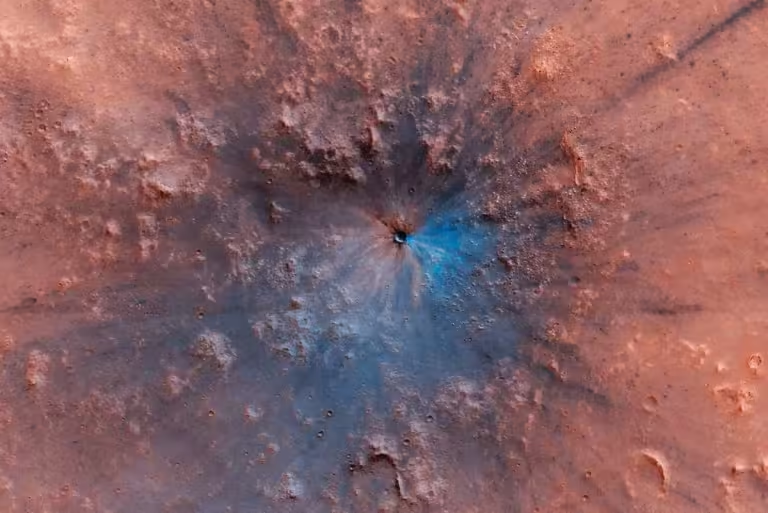
An impact crater on Mars, revealing dark material beneath reddish dust.
NASA/JPL-Caltech/University of Arizona
Six Martian meteorites have been traced back to where they erupted from Martian craters millions of years ago, and knowing the origins of these alien rocks can help place them in context and provide insight into the history of the Red Planet.
“Determining the impact launch site of Martian meteorites has long been a challenging goal,” says Hap McSween of the University of Tennessee, Knoxville, who was not involved in the study. “There have been numerous published attempts, but none have been convincing until now.”
When rocks hit Mars or other planets, they send debris flying, some of which may drift through space and eventually hit Earth as meteorites. Anthony Ragain of Curtin University in Australia and his colleagues used advanced models that match what we know about Mars’ millions of craters and the ages of six meteorites that have been chipped away at the Martian surface.
“There are about 80,000 craters on Mars that are larger than two miles in diameter, so there are about 80,000 craters that could be the source of these meteorites,” Ragain says. The researchers’ model narrowed down the possible sources to about 20. They then looked at the rocks’ structure to see how suddenly they were subjected to force when they were hurled into space, and fed that into another model of the craters themselves. This allowed them to determine the meteorite’s original source and how deep it was buried before falling to Earth.
The meteorites are all igneous, meaning they’re pieces of solidified lava. Pete Mouginis Mark of the University of Hawaii at Manoa says it’s questionable whether the characteristics of the lava flows in these craters match up perfectly with meteorites, but if these craters are indeed the source of the rocks, they could tell us a lot about volcanism on Mars.
In particular, two of the meteorites thought to have come from the same crater suggest that the region has been volcanically active for longer than previously thought. “This may force us to rethink the ‘plumbing systems’ we think exist inside Martian volcanoes and how they can remain molten for such long periods of time,” Mouzinis-Mark says.
Only about 200 Martian meteorites exist on Earth, making them the only Martian rocks that researchers can study in detail. NASA’s planned mission to bring samples directly from Mars faces significant problems that could lead to significant delays. So these rocks may be our only chance to study Martian materials in cutting-edge laboratories. “Here we have six Martian meteorites from five locations, so it’s like we get five sample-return missions for free,” says Ragain. Further study of these samples will not only tell us about the evolution of Mars, but will also help guide future exploration to the most scientifically interesting places on the surface.
topic:
(Tag ToTranslate) Martian meteor

